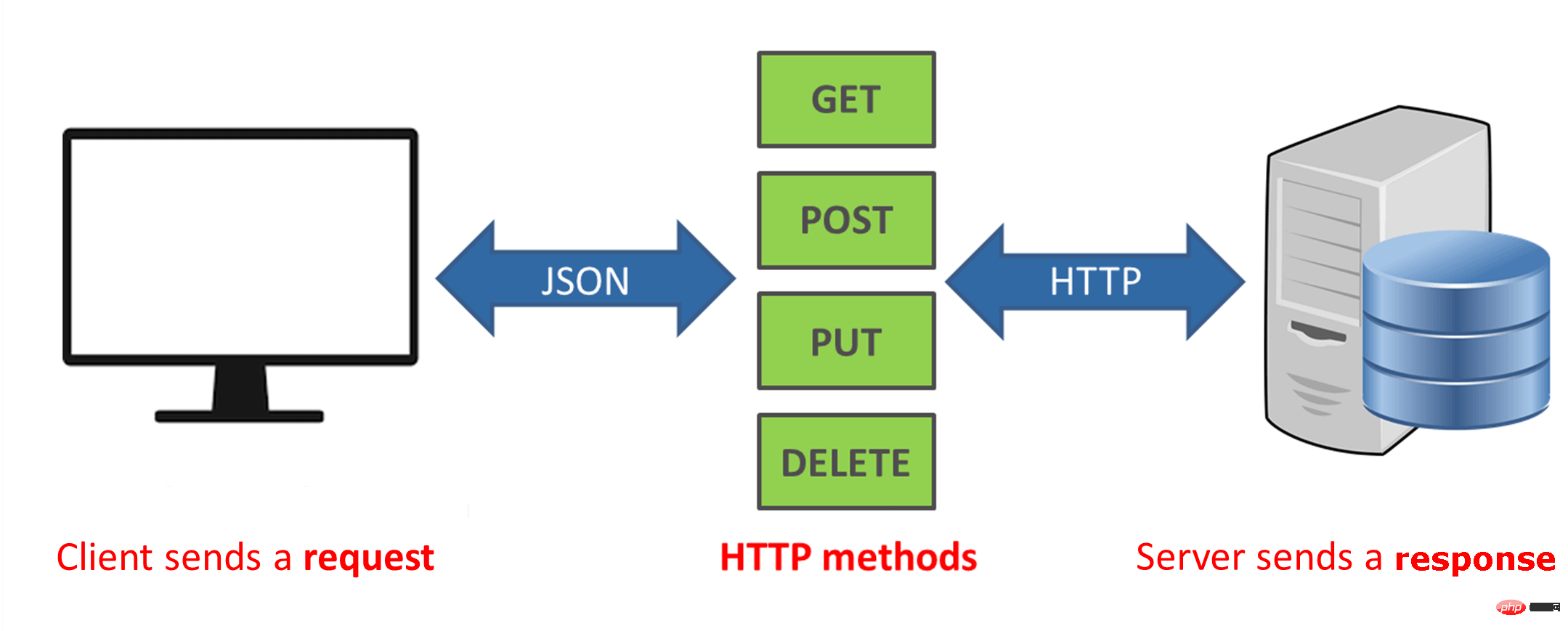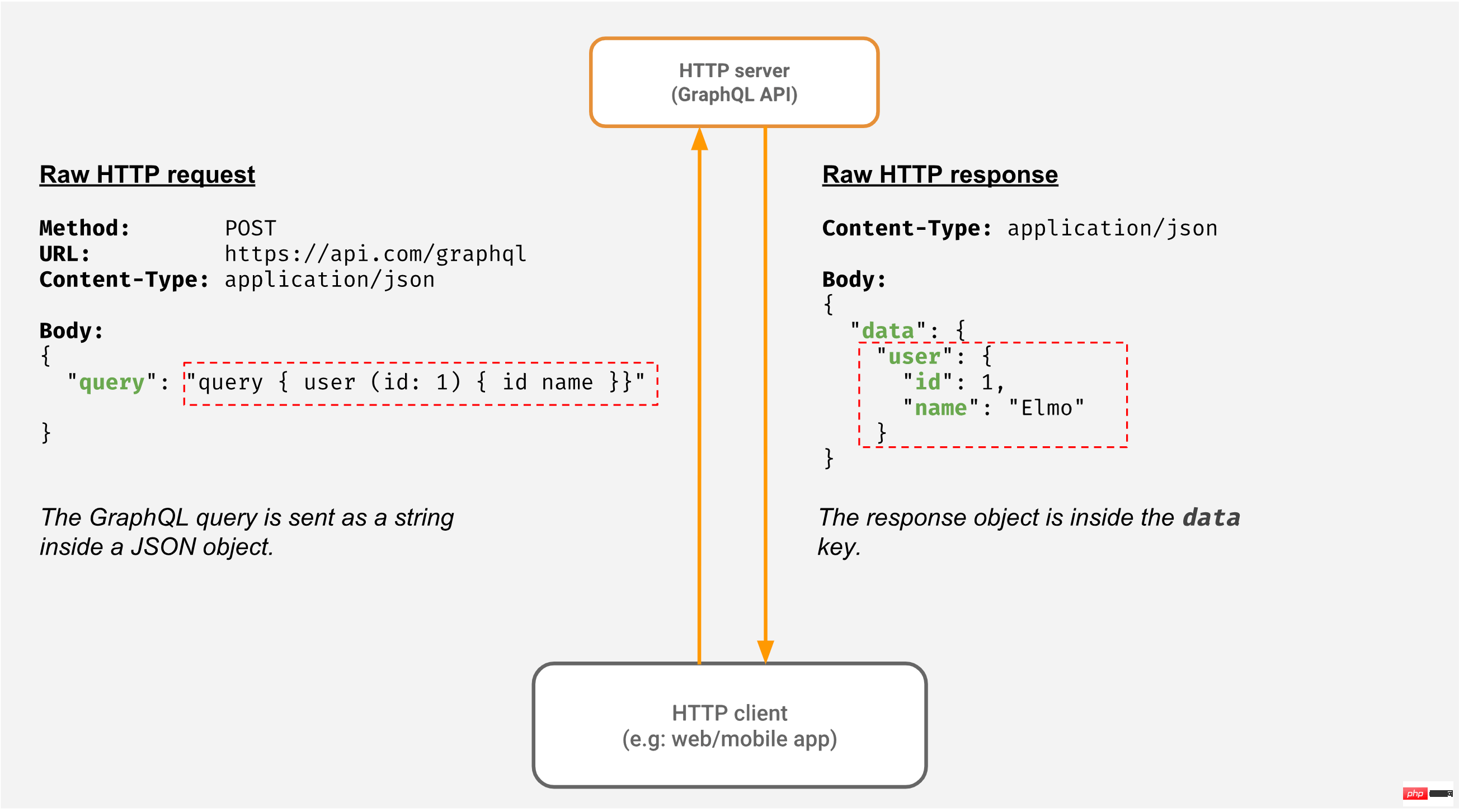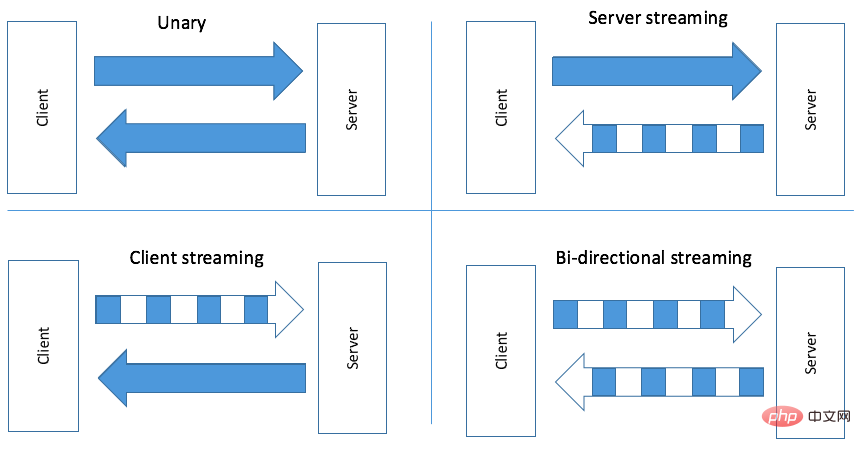 Backend Development
Backend Development
 Python Tutorial
Python Tutorial
 Technology Selection: How to Choose REST, GraphQL, and gRPC
Technology Selection: How to Choose REST, GraphQL, and gRPC
Technology Selection: How to Choose REST, GraphQL, and gRPC
REST, GraphQL, and gRPC are the 3 most popular API development technologies for modern web applications. So when making technology selection, how to choose among the three?
In this article, we will compare the features and usage of REST, GraphQL and gRPC.
REST - The most popular technology

REST
Representational State Transfer (REST) It is the most popular API development technology in modern web development. It is a stateless data transfer architecture. The client's request includes all the details required for the request, but the server does not retain the client's state.
REST API supports HTTP native caching headers and uses HTTP methods (POST, GET, PUT, PATCH and DELETE) to manipulate data. Because the learning threshold for REST is low, everyone can use REST easily.
REST is easy to extend and reliable. If we are still hesitant, we can choose it first.
Benefits of REST- You can safely use standard HTTP methods to implement CRUD operations.
- REST is very mature, has complete documentation, and is easy to get started.
- Support caching.
- Friendly to scalability and provides separation between client and server.
- Can be easily integrated into the application.
- There are problems of over-acquisition and under-acquisition. Overfetching occurs when an API returns more data than is actually needed. This can result in unnecessary network traffic, slower performance, and extra bandwidth usage. Underfetching occurs when an API does not return all necessary data required for a specific use case, requiring multiple requests to retrieve all required information. This can also result in slower performance and increased network traffic, as well as a more complex code base.
- Cannot maintain status.
- Relatively large payload.
- As the application scales, the number of endpoints increases dramatically.
- Not easy to update the database schema or data structure.
If there are no specific requirements, REST is the best choice. If you are new to development, using REST is perfect because it has a shallow learning curve. Additionally, it has a huge ecosystem where you can easily find solutions to your problems.
REST is best used when handling larger request volumes and with limited bandwidth, as its caching support can be used to improve performance.
In general, if your application does not explicitly need to use GraphQL or gRPC, then use REST.
GraphQL - Client-Driven Standard
GraphQL is a data technology launched in 2015 A query language that enables developers to locate and obtain exactly the data they need. Compared to REST, GraphQL is a client-driven approach where the client decides what data is needed, how to get it and the format. It also solves the problems of over-fetching and under-fetching because the client can explicitly specify the data it needs.
GraphQL uses queries, mutations, and subscriptions to manipulate data.
- Query: Request data from the server.
- Change: Modify server-side data.
- Subscription: When the data is updated, obtain real-time updated data through subscription.
#GitHub is one of the largest companies using GraphQL. Its switch from REST to GraphQL in 2016 has greatly helped GitHub's rapid growth.
Benefits of GraphQL
- It is very flexible and can meet the needs of customers accurately.
- There is no problem of over-acquisition and under-acquisition.
- Mainstream language support, including JavaScript, Java, Python, Ruby and PHP.
- Allows custom data structure.
- A single query can contain fields from multiple resources.
Disadvantages of GraphQL
- Queries can be complex.
- Lack of built-in caching support.
- Learning GraphQL is more challenging compared to REST.
- File uploading is not supported by default.
When to Choose GraphQL
When the query contains many records from the database, GraphQL is the best choice. You can use GraphQL to eliminate overfetching and query only necessary data to improve application performance. Additionally, GraphQL is ideal for situations where data needs to be aggregated from multiple sources.
You can also use GraphQL when you don’t fully understand how the client uses the API. When using GraphQL, you don’t need to define a strict protocol up front and can gradually build your API based on customer feedback.
gRPC - a performance-oriented technology

gRPC was launched by Google in 2016 An evolved version of remote procedure calls introduced. It is a lightweight solution that provides maximum performance using minimum resources.
gRPC follows a protocol-based communication approach. It requires that both client and server have an agreement before starting communication. gRPC uses Protobuf, a declarative language, to create protocols and generate compatible code for clients and servers in the chosen language.
gRPC supports 4 communication methods:
- Unary: The client sends a request and waits for a single response.
- Server streaming: The client sends a request and receives multiple responses.
- Client streaming: The client sends multiple requests and waits for a single response.
- Bidirectional streaming: The client sends multiple requests and receives multiple responses.
Benefits of gRPC
- Open source. Developers can modify it as needed.
- Supports multiple languages, including JavaScript, Java, C, C++, C#, Kotlin, Python, Go and PHP.
- Able to perform load balancing.
- It uses HTTP2 by default to reduce latency compared to REST API.
- Serialize data using binary format.
- Supports full-duplex streaming.
Disadvantages of gRPC
- Steep learning curve: Compared with traditional REST API, gRPC requires mastering new concepts and technologies, such as Protocol Buffers and streams.
- Poor readability: Due to the use of binary encoding, gRPC messages are not as easy for humans to read and understand as JSON or XML.
- Difficult to debug: Since messages are binary encoded, debugging a gRPC service can be more difficult than debugging a REST API.
- Not suitable for small applications: For small applications with only a few services and a small amount of data, gRPC may be too complex and add unnecessary overhead.
- Does not support web browsers: Since gRPC uses the HTTP/2 protocol, and web browsers currently do not support all features of the HTTP/2 protocol, they cannot be used in web browsers. gRPC.
When to choose gRPC
- Requires efficient data transfer: Since gRPC uses a binary protocol, it is faster than text protocols like JSON and XML , more lightweight.
- Need high reliability: gRPC's transport layer based on the HTTP/2 protocol provides many functions, such as flow control, connection multiplexing and header compression, etc., which can improve reliability sex and performance.
- Need for efficient multi-language communication: gRPC supports multiple programming languages and provides tools to automatically generate code, so there is no need to manually write cross-language code.
- Need to support multiple request and response types: gRPC supports four types of communication methods (Unary, Server streaming, Client streaming and Bidirectional streaming), so you can choose the one that best suits your specific use case way of communication.
- Need for better API management: gRPC provides powerful API management tools, such as gRPC-Gateway and Envoy, etc. These tools can improve API discoverability, documentation and testing .
gRPC can be used in microservices architecture to handle communication between services, as it can communicate with services written in different languages.
Conclusion
The choice of REST, GraphQL and gRPC depends on your specific scenarios and needs. The basic principles are summarized as follows:
- REST: REST is suitable for simple APIs and web services, such as traditional CRUD operations. It's generally easier to understand and use, and has an extensive ecosystem of support and tools.
- GraphQL: GraphQL is suitable for applications that require flexibility and advanced query capabilities. If your application needs to aggregate data from multiple resources, or needs better control over the format and granularity of the data, GraphQL is a good choice.
- gRPC: gRPC is suitable for applications that require efficient and reliable data transfer. If you need efficient communication between multiple programming languages and want to provide higher performance and reliability, gRPC is a good choice.
However, REST, GraphQL and gRPC are not mutually exclusive choices. In actual situations, you can combine them to meet specific needs and scenarios.
The above is the detailed content of Technology Selection: How to Choose REST, GraphQL, and gRPC. For more information, please follow other related articles on the PHP Chinese website!

Hot AI Tools

Undresser.AI Undress
AI-powered app for creating realistic nude photos

AI Clothes Remover
Online AI tool for removing clothes from photos.

Undress AI Tool
Undress images for free

Clothoff.io
AI clothes remover

Video Face Swap
Swap faces in any video effortlessly with our completely free AI face swap tool!

Hot Article

Hot Tools

Notepad++7.3.1
Easy-to-use and free code editor

SublimeText3 Chinese version
Chinese version, very easy to use

Zend Studio 13.0.1
Powerful PHP integrated development environment

Dreamweaver CS6
Visual web development tools

SublimeText3 Mac version
God-level code editing software (SublimeText3)

Hot Topics
 Four recommended AI-assisted programming tools
Apr 22, 2024 pm 05:34 PM
Four recommended AI-assisted programming tools
Apr 22, 2024 pm 05:34 PM
This AI-assisted programming tool has unearthed a large number of useful AI-assisted programming tools in this stage of rapid AI development. AI-assisted programming tools can improve development efficiency, improve code quality, and reduce bug rates. They are important assistants in the modern software development process. Today Dayao will share with you 4 AI-assisted programming tools (and all support C# language). I hope it will be helpful to everyone. https://github.com/YSGStudyHards/DotNetGuide1.GitHubCopilotGitHubCopilot is an AI coding assistant that helps you write code faster and with less effort, so you can focus more on problem solving and collaboration. Git
 Which AI programmer is the best? Explore the potential of Devin, Tongyi Lingma and SWE-agent
Apr 07, 2024 am 09:10 AM
Which AI programmer is the best? Explore the potential of Devin, Tongyi Lingma and SWE-agent
Apr 07, 2024 am 09:10 AM
On March 3, 2022, less than a month after the birth of the world's first AI programmer Devin, the NLP team of Princeton University developed an open source AI programmer SWE-agent. It leverages the GPT-4 model to automatically resolve issues in GitHub repositories. SWE-agent's performance on the SWE-bench test set is similar to Devin, taking an average of 93 seconds and solving 12.29% of the problems. By interacting with a dedicated terminal, SWE-agent can open and search file contents, use automatic syntax checking, edit specific lines, and write and execute tests. (Note: The above content is a slight adjustment of the original content, but the key information in the original text is retained and does not exceed the specified word limit.) SWE-A
 Learn how to develop mobile applications using Go language
Mar 28, 2024 pm 10:00 PM
Learn how to develop mobile applications using Go language
Mar 28, 2024 pm 10:00 PM
Go language development mobile application tutorial As the mobile application market continues to boom, more and more developers are beginning to explore how to use Go language to develop mobile applications. As a simple and efficient programming language, Go language has also shown strong potential in mobile application development. This article will introduce in detail how to use Go language to develop mobile applications, and attach specific code examples to help readers get started quickly and start developing their own mobile applications. 1. Preparation Before starting, we need to prepare the development environment and tools. head
 Which Linux distribution is best for Android development?
Mar 14, 2024 pm 12:30 PM
Which Linux distribution is best for Android development?
Mar 14, 2024 pm 12:30 PM
Android development is a busy and exciting job, and choosing a suitable Linux distribution for development is particularly important. Among the many Linux distributions, which one is most suitable for Android development? This article will explore this issue from several aspects and give specific code examples. First, let’s take a look at several currently popular Linux distributions: Ubuntu, Fedora, Debian, CentOS, etc. They all have their own advantages and characteristics.
 How to deal with Laravel API error problems
Mar 06, 2024 pm 05:18 PM
How to deal with Laravel API error problems
Mar 06, 2024 pm 05:18 PM
Title: How to deal with Laravel API error problems, specific code examples are needed. When developing Laravel, API errors are often encountered. These errors may come from various reasons such as program code logic errors, database query problems, or external API request failures. How to handle these error reports is a key issue. This article will use specific code examples to demonstrate how to effectively handle Laravel API error reports. 1. Error handling in Laravel
 Oracle API Usage Guide: Exploring Data Interface Technology
Mar 07, 2024 am 11:12 AM
Oracle API Usage Guide: Exploring Data Interface Technology
Mar 07, 2024 am 11:12 AM
Oracle is a world-renowned database management system provider, and its API (Application Programming Interface) is a powerful tool that helps developers easily interact and integrate with Oracle databases. In this article, we will delve into the Oracle API usage guide, show readers how to utilize data interface technology during the development process, and provide specific code examples. 1.Oracle
 Oracle API integration strategy analysis: achieving seamless communication between systems
Mar 07, 2024 pm 10:09 PM
Oracle API integration strategy analysis: achieving seamless communication between systems
Mar 07, 2024 pm 10:09 PM
OracleAPI integration strategy analysis: To achieve seamless communication between systems, specific code examples are required. In today's digital era, internal enterprise systems need to communicate with each other and share data, and OracleAPI is one of the important tools to help achieve seamless communication between systems. This article will start with the basic concepts and principles of OracleAPI, explore API integration strategies, and finally give specific code examples to help readers better understand and apply OracleAPI. 1. Basic Oracle API
 Exploring Go language front-end technology: a new vision for front-end development
Mar 28, 2024 pm 01:06 PM
Exploring Go language front-end technology: a new vision for front-end development
Mar 28, 2024 pm 01:06 PM
As a fast and efficient programming language, Go language is widely popular in the field of back-end development. However, few people associate Go language with front-end development. In fact, using Go language for front-end development can not only improve efficiency, but also bring new horizons to developers. This article will explore the possibility of using the Go language for front-end development and provide specific code examples to help readers better understand this area. In traditional front-end development, JavaScript, HTML, and CSS are often used to build user interfaces





